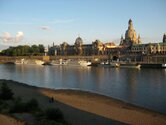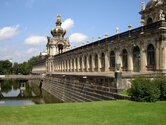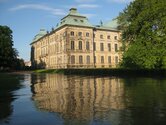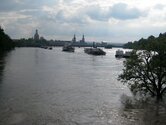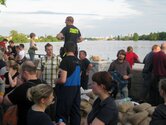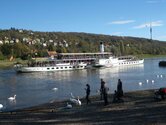Abstract Of Dresden History
On a visit in the town the guest in our vacation appartements in Dresden is faced with history everywhere. That is why a brief outline of the changeful history of the town is given to tease the reader, travaller and visitor in the first place, before giving facts.
Dresden’s Early History Until Second World War
Already in stone age settlements were existing at this place at the banks of the river Elbe. In 1206 Dresden was first mentioned in records. The then name of the town was "Dresdene", that probably originates from the Slavic "Dreždany", meaning “inhabitant of the lowland riparian forest”. At the end of the 15th century Dresden was made seat of government by the Wettin dynasty and thus became residential city of the Saxon rulers. In 1685 the on the right, northern bank of the Elbe situated Altendresden (Olden Dresden) was destroyed by a serious fire. This area of the town was rebuild as the “New King’s Town”, today the Inner New City, with magnificent baroque buildings. Elector Friedrich August I., named also August the Strong (1670 – 1733), started his sovereignty in 1694. Under his leadership Dresden evolved into an arts and cultural centre. In 1760 the Prussians invaded and destroyed large parts of the town. Monarchy was abolished in 1918 and Dresden became capital of the Free State of Saxony.
Death and Destruction in the Second World War
After the National Socialists came into power in the year 1933 the Saxon Parliament was dissolved. Up to the end of World War II Dresden was untroubled by air raids and destruction. Between February 13 and February 14, 1945, Dresden became victim of the biggest air raid in the Second World War. Historians continue to debate the bombing of Dresden. Some now describe it as immoral or a war crime, and no other Allied raid has attracted more condemnation than that launched on the night of February 13, 1945. Records show that RAF (Royal Air Force) and USAF (United States Air Force) Command carried out an incendiary raid on a city that had hitherto escaped destruction. There after the issues is contentious. Without doubt it was an annihilation ; if the obliteration of the architectural hem of Germany does not put the raid in a different class, the casualty figures do. Around 25.000 – 35.000 people where killed in a city swollen by refugees, always sketchy at the time, the number of dead was exaggerated first by Nazis propagandists, who stated that 200.000 had died, then by the communists, who put the figure at 135.000. Thereby the city centre of Dresden, and with this many of the baroque works of art were destroyed almost completely on both sides of the river Elbe. Not until 1951 the citizens of Dresden began with the reconstruction of the city centre.
Dresden in the East German Times
By breaking up the state of Saxony in the GDR (German Democratic Republic) in 1952 Dresden lost its function as a regional capital. During the times of the GDR (1949 - 1989) many remains of the old town were removed, and ruins blasted. Very few of the old Buildings were repaired. Whole settlements of modern blocks of flats were built in the districts Prohlis and Gorbitz to put an end to housing shortage. At the 40th anniversary of the destruction of Dresden in the year 1985 the Semper Opera House was reinaugurated after eight years of construction. After that the rebuilding of Dresden Castle (Residenzschloss) started in 1986.
The eventful history of the Dresden Baroque quarter
Read more about the history of the Baroque District in Dresden ...
Dresden Today
In the course of the German reunification in 1990 Dresden again became regional capital of the Free State of Saxony. Considering new town planning aspects, reconstruction and restoration of the old buildings in the city centre began. These operations are completed today at the most important historical buildings. Just a few of them are still in the state of rebuilding, which can be observed by the still busy building activity in the town. In summer 2002 the town fell victim to the so-called “High Tide of the Century”. Many historical Buildings suffered damages by this flooding, e.g. the Zwinger Palace, the Picture Gallery, the Semper Opera House, the Playhouse (Schauspielhaus theatre), the Catholic Hofkirche, and the Saxon Parliament. Today these damages are nearly imperceptible and removed completely. The consecration of the re-erected Church of Our Lady in the year 2005 gave another highlight to the beauty and attractiveness of the town.



